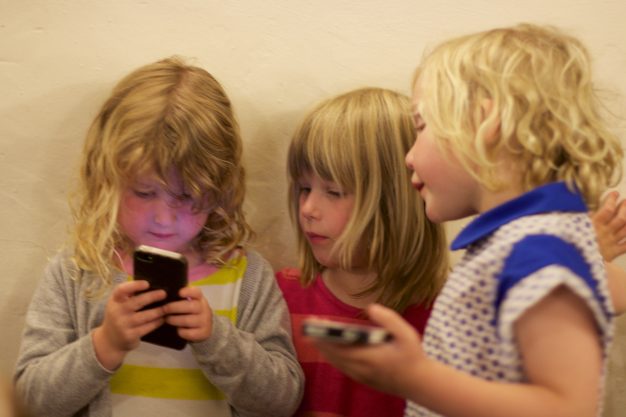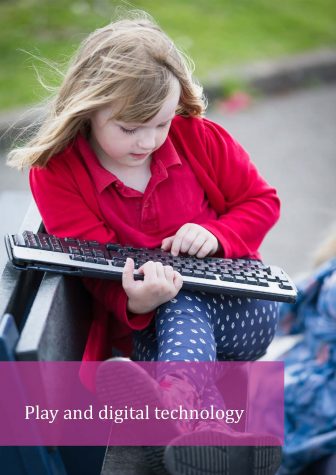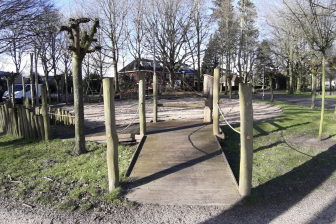
Are smart phones really the death of children’s play?
Many of the current conversations on children’s use of mobile phones sound dire warnings, even foretelling the ‘death of childhood’ itself. However, argues playworker and geographer Chris Martin, different standpoints can contribute alternative, more complex perspectives, suggesting that children’s play may be as rich in the technological age as it ever was.
Accessing the internet via a stationary computer has given way to the tablet and mobile phone, with children acquiring increasingly ‘smart’ phones at ever younger ages – usually in the UK at age 10 to 12 years (Livingstone, Haddon, Vincent, Mascheroni, & Ólafsson, 2014). Critical study into how children and mobile digital technology interact in freely chosen play, especially outdoors, is, however, virtually unexplored territory.
Children don’t necessarily use their phones or engage in ‘traditional’ play: sometimes they do both at the same time. Examining this interweaving offers a non-polarised perspective rather than ‘getting a balance’ between digital and more ‘traditional’ play, which still casts these two as opposite. Research with younger children suggests that as individuals they display similar offline and online activities and play preferences (Marsh, 2010) and blur the boundaries between online and offline, with ‘communication and play that moves across physical and virtual domains and integrates material and immaterial practices.’ (Marsh, Plowman, Yamada-Rice, Bishop, & Scott, 2016)
Not second-best
Children use mobile phones according to the affordances offered and perceived by varying outdoor spaces and circumstances (Martin, 2017). Who they are with, what they are doing, and who is watching them also affects their use; as do adults, who are still the gatekeepers and bill-payers (Ruckenstein, 2013). If adults wittingly or unwittingly restrict access to certain spaces for play, on streets for example, then children will choose other places, and increasingly these are digital ones. If children look bored and immersed in their phones, the chances are that they consider their surroundings and what’s on offer to be boring. Children don’t believe that using their phones to access digital worlds is second-best or ‘virtual’ play; to them it is play (Marsh, 2010), and often more interesting than what is on offer from identikit playgrounds.
Recent fieldwork carried out as part of my PhD research at Leicester University suggests that children do get excited about their phones and rarely leave home without them, but they also express frustration with their distractions. There is general agreement amongst participants of focus groups that YouTube in particular diverts them from playing outdoors.
When the children are playing outside, their phones often lie forgotten at the bottom of backpacks, casually thrown by the skate park ramp or at the base of the tree.
Children still prefer to play outside and, when they do, most of the time they use their phones for banal activities. They check the time, contact their friends to see where they are, and ignore texts from parents to return to their homework. When the children are engaged in outdoor play their phones often lie forgotten at the bottom of backpacks casually thrown by the skate park ramp or at the base of the tree.
Digital spaces are, however, monopolised by providers of social media. These huge companies understand ‘the corporate value of sociality’ (Ruckenstein, 2013, p. 477). Many adults understand the social (and educational and other) value of play and try and effect change. Through living their play children may well surprise and subvert adult agendas, supported by adults who actively advocate for ‘letting them play’.
Chris Martin
Chris is a playworker, researcher, and play activist. He is currently researching children’s interactions with mobile digital technology for his PhD at the University of Leicester, UK
Photo: Richard Leeming
Bibliography
Livingstone, Haddon, L., Vincent, J., Mascheroni, G., & Ólafsson, K. (2014). Net Children Go Mobile: The UK Report. Retrieved from London:
Marsh, J. (2010). Young children’s play in online virtual worlds. Journal of Early Childhood Research, 8(1), 23-39. doi:10.1177/1476718X09345406
Marsh, J., Plowman, L., Yamada-Rice, D., Bishop, J., & Scott, F. (2016). Digital play: a new classification. Early Years, 1-12. doi:10.1080/09575146.2016.1167675
Martin, C. (2017). Children, Mobile Phones and Outdoor Play. In W. Russell, H. Smith, & S. Lester (Eds.), Practice-based Research in Children’s Play. Bristol: Policy Press.
Ruckenstein, M. (2013). Spatial extensions of childhood: from toy worlds to online communities. Children’s Geographies, 11(4), 476-489. doi:10.1080/14733285.2013.812309

Chris Martin is the author of a new briefing on Play and digital technology, published by Play Wales.
The briefing paper can be read here




